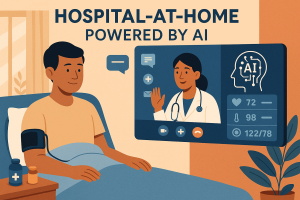Hospital-at-Home Programs in Southeast Asia: Powered by AI
AI-Powered Hospital-at-Home in Southeast Asia | 2025
Discover how Southeast Asia is revolutionizing healthcare through AI-powered hospital-at-home programs and remote patient monitoring systems.
 Introduction
Introduction
Hospital-at-home (HaH) programs are redefining healthcare delivery across Southeast Asia. Enabled by artificial intelligence and remote patient monitoring technologies, these initiatives allow patients to receive hospital-level treatment from the comfort of their homes. Countries like Singapore, Thailand, and Malaysia are spearheading this shift to improve clinical outcomes, reduce hospital overcrowding, and expand care access in both urban and remote settings.
1. What Is Hospital-at-Home (HaH)?
Hospital-at-home refers to the delivery of acute care services in a patient’s residence rather than in a hospital. This care model replicates inpatient services using telemedicine, AI-driven diagnostics, wearable medical sensors, and virtual nursing teams. It is being applied in:
-
Post-surgical recovery
-
Chronic disease management (e.g., heart failure, diabetes)
-
Elderly care and palliative care
-
Infectious disease isolation (e.g., COVID-19, influenza)
2. The Role of Artificial Intelligence
AI technologies are central to the success of HaH models in Southeast Asia. Key applications include:
-
Predictive analytics to detect early signs of health deterioration
-
AI triage systems to prioritize urgent cases
-
Automated medication reminders and treatment schedules
-
NLP-based chatbots for real-time patient communication
These solutions reduce clinical workload while ensuring timely, personalized interventions.
3. Country Spotlights: SEA HaH Initiatives
Singapore
Public hospitals collaborate with digital health startups to deploy AI dashboards and wearable monitoring in pilot HaH programs, supported by government funding and telehealth regulation reforms.
Thailand
The Ministry of Public Health is trialing AI-powered home monitoring systems in smart community health centers to support chronic care for the aging population.
Malaysia
Revised 2023 telemedicine laws enable licensed providers to offer virtual wards, remote diagnostics, and at-home nursing for post-acute patients.
4. Remote Patient Monitoring (RPM) Tools
AI-powered RPM systems form the digital backbone of HaH programs. These platforms provide:
-
Continuous tracking of vitals like heart rate, blood oxygen, and glucose levels
-
Emergency alerts when values cross risk thresholds
-
Compliance monitoring with prescribed treatments
-
Video consultations and mobile chat interfaces
Such tools ensure timely medical response and peace of mind for both patients and providers.
5. Benefits of AI-Powered HaH Programs
-
Reduced hospital load: Frees up inpatient beds and lowers healthcare costs
-
Improved patient experience: Familiar home environments promote faster recovery
-
Increased access: Bridges gaps in underserved areas
-
Better chronic care: Enables proactive management of long-term conditions
-
Continuity of care: Supports seamless post-discharge monitoring
6. Barriers and Challenges
Despite the promise of HaH programs, several challenges remain in Southeast Asia:
-
Digital infrastructure: Limited internet in rural zones hampers RPM usage
-
Data security: Concerns over patient privacy and device encryption
-
Workforce limitations: Shortage of AI-literate clinical staff
-
Cultural acceptance: Some patients still prefer in-hospital treatment
Addressing these requires collaboration between governments, private health providers, and tech developers.
7. Opportunities for Exporters and Innovators
The demand for AI-powered home healthcare is creating significant opportunities for:
-
Diagnostic equipment manufacturers (e.g., portable ECGs, glucose monitors)
-
Health software developers (e.g., AI triage, telehealth apps)
-
Wearable device brands focused on medical-grade monitoring
-
Distributors of smart beds, wireless stethoscopes, and connected infusion pumps
Companies aligned with regional regulations and patient-centric design will thrive in this emerging space.
Conclusion
Hospital-at-home programs powered by AI are transforming Southeast Asia’s healthcare ecosystem. By blending advanced monitoring with compassionate home-based care, the region is paving the way for a smarter, more inclusive future. For global medical exporters, innovators, and health professionals, now is the time to engage with this growing frontier.
👉 Learn more about smart diagnostic solutions at www.xinrea.com
